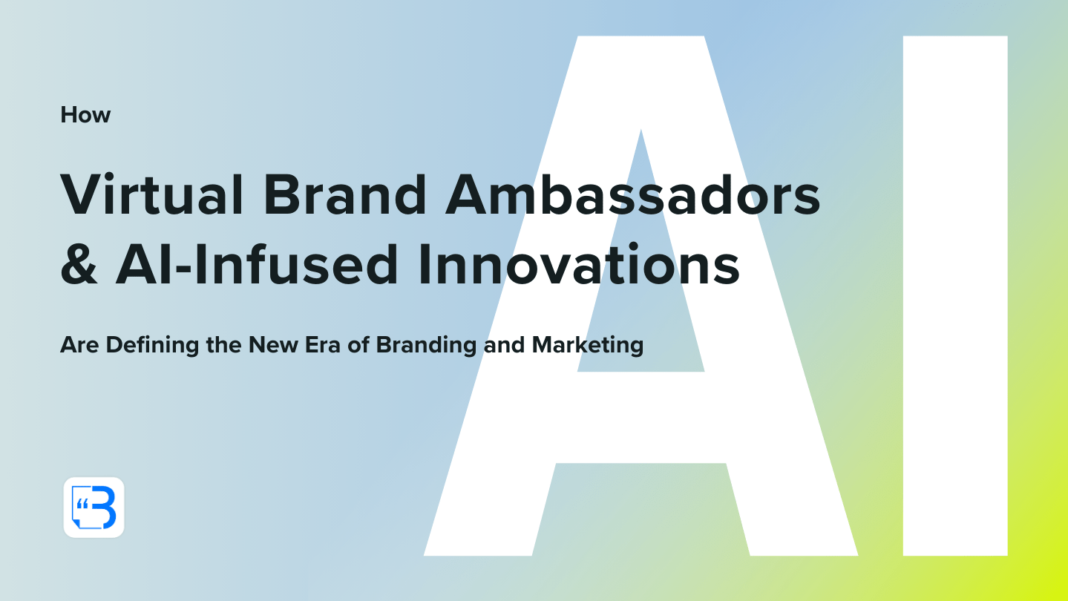The digital age is in perpetual flux, continuously reshaping the landscape of brand engagement and consumer interaction. As we step into 2023, the transformative power of Artificial Intelligence (AI) stands out as the pivotal force behind this evolution. One of the most groundbreaking innovations propelling this change is the concept of virtual brand ambassadors powered by AI models such as GPT-4. These ambassadors are not merely digital representations but are meticulously crafted entities that encapsulate the very essence and values of a brand. They promise to revolutionize the way consumers interact with brands, bringing about an unprecedented level of personalization and round-the-clock engagement.
Simultaneously, as brands aim to remain at the forefront of this digital metamorphosis, understanding and assimilating the myriad possibilities offered by AI becomes crucial. Beyond the allure of virtual brand ambassadors, AI is reimagining multiple facets of branding, from personalized storytelling to dynamic pricing strategies. This intricate dance of AI-driven innovations offers brands an unparalleled opportunity to elevate user experiences, foster deeper emotional connections, and pave the way for a future where branding isn’t just about recognition, but about resonant, personalized experiences.
As we delve deeper into this discussion, it becomes evident that the synergy between AI and branding is not just a fleeting trend but a new paradigm. A paradigm where technology and human-centric branding converge, heralding a new era of marketing where brands and consumers co-create meaningful narratives and experiences.
Table of Contents

The Role of GPT-4: Hyper-Realistic Virtual Brand Ambassadors
In the current digital landscape, there’s been a paradigm shift in how brands approach their audiences. GPT-4, a sophisticated AI language model, sits at the epicenter of this transformation, introducing the world to hyper-realistic virtual brand ambassadors. This breakthrough isn’t just technological; it’s fundamentally altering the dynamics of brand representation in the digital realm.
- Virtual Brand Ambassadors: Representing brands in today’s saturated market requires innovation, distinction, and continuous presence. These virtual brand ambassadors, a blend of cutting-edge AI and detailed brand knowledge, do just that. As AI-driven entities, they encapsulate the core values of brands, offering an unparalleled level of customer engagement. Unlike traditional brand representatives, these ambassadors are present 24/7, ensuring that the brand’s voice, ethos, and assistance are consistently available. This presence underscores the importance and potential of virtual brand ambassadors in bridging the gap between brands and their audiences.
- Hyper-Realism: The true value of GPT-4-driven virtual brand ambassadors lies in their uncanny ability to imitate human nuances. Emotions, expressions, accents – elements that make interactions genuine – are perfectly mimicked. This degree of realism fosters a sense of trust and intimacy in interactions, making brand experiences more personal and memorable.
Nike, a brand synonymous with innovation, recognized the potential of GPT-4 early on. Their introduction of NikeFitPro wasn’t just about a new product; it was about setting a new standard in customer engagement. This GPT-4 powered virtual coach, beyond offering tailored workout routines and nutrition advice, considers user feedback and preferences. The result? A truly individualized fitness experience that not only guides users but motivates them, encapsulating the brand’s commitment to personal excellence.
AI-Generated Storytelling: Crafting Unique Brand Narratives with Machine Learning
In an era where digital interactions dominate, AI-powered storytelling stands at the forefront, offering businesses a groundbreaking way to engage with their audiences. By harnessing artificial intelligence, the creation and delivery of narratives have transcended traditional boundaries, paving the way for virtual brand ambassadors to tell tales that are not only original but also deeply resonating.
- The Power of Narrative: Storytelling has always been a cornerstone of human communication. In branding, it’s how companies weave emotional and psychological connections, allowing consumers to see beyond a product or service to the ethos and values behind it. With AI and virtual brand ambassadors taking the reins, these stories become more interactive, immersive, and intimately tailored, allowing consumers to not just hear a brand’s story but to feel and live it.
- Machine Learning Narratives: Machine Learning’s power to sift through and interpret vast datasets is transformative. By understanding intricate consumer behavior patterns, preferences, and histories, AI crafts narratives that resonate deeply on an individual level. Instead of a one-size-fits-all story, brands can now convey myriad tales, each tailored for a specific audience segment, ensuring maximum impact and engagement.
- Content Generation: In the age of constant content consumption, producing timely, relevant, and high-quality content is paramount. AI steps in as a game-changer, automating content generation processes. From crafting compelling blog posts and timely social media updates to scripting videos that captivate, AI ensures that content is not just produced but crafted with precision and purpose.
Netflix, a brand celebrated for its innovation, embodies the potential of AI-driven storytelling. By integrating AI methodologies with its recommendation engine, the platform does more than suggest content. It crafts experiences. Every recommendation is a chapter in a personalized narrative, ensuring that audiences not only consume content but feel a deeper connection to it. By providing tailored viewing experiences, Netflix fortifies brand loyalty and ensures audiences remain continuously engaged.
AI-Enhanced Product Customization: Personalized Branding at Scale
Branding, in its essence, is about creating unique identities. With the advent of AI-driven product customization, brands can now sculpt experiences tailored to individual preferences at an unprecedented scale. This personalization, previously deemed challenging, is now within grasp, leveraging cutting-edge software like Squadhelp and the strategies employed by virtual brand ambassadors.
- Mass Personalization: In today’s competitive market, consumers crave products and services that reflect their unique identities and preferences. AI empowers brands with this capability. By analyzing vast reservoirs of consumer data, AI enables brands to craft offerings that feel personal, unique, and exclusive, enhancing overall consumer experience and driving brand loyalty.
- Recommendation Engines: Beyond crafting personalized products, it’s vital that these offerings reach the right audience. AI’s recommendation engines dive deep into user behaviors, past preferences, and even subtle inclinations, predicting and suggesting products that users are most likely to resonate with. This not only enhances user experience but also drives sales and brand affinity.
- Supply Chain Optimization: Personalization extends beyond the product. It’s about delivering a seamless and efficient experience. AI aids in optimizing inventory management, production schedules, and delivery processes, ensuring that personalized orders are handled with the utmost efficiency, meeting demands without hitches.
A shining example of this AI-enhanced personalization is Coca-Cola‘s “Share a Coke” campaign. By harnessing AI to delve into consumer data, Coca-Cola brought a personal touch to each bottle and can, imprinting popular names from social platforms. Beyond names, personalized messages deepened the bond between consumer and brand. Every sip of Coca-Cola became a personal experience, a testament to the power of AI in branding, making each purchase not just a transaction but a memory.
Check our related articles:
Generative Design in Branding: AI-Generated Logos and Visual Identities
Branding in the digital age has taken a transformative turn with the introduction of Artificial Intelligence. AI’s foray into visual identity creation through generative design promises not just logos but entire visual identities that are distinct, dynamic, and deeply reflective of brand values. These AI-created designs can act as the bedrock upon which virtual brand ambassadors stand and communicate.
- Visual Identity: Visual elements are often a brand’s first impression, making them invaluable. AI steps beyond traditional design methods, offering the capability to generate logos, select color schemes, and craft design elements that aren’t just aesthetically pleasing but are also aligned with the brand’s essence. This ensures that when virtual brand ambassadors communicate, they do so with a backdrop that resonates with the brand’s ethos.
- Efficiency and Consistency: With the vast digital landscape that brands navigate today, consistency in visual branding is crucial. AI aids in this by ensuring that logos, color schemes, and other design elements maintain uniformity across platforms, from websites to mobile apps to promotional materials.
Airbnb‘s innovative approach to branding showcases the potential of AI-driven generative design. By employing AI algorithms, Airbnb consistently refines its logo, pulling insights from user reviews, host locations, and guest experiences. This ever-evolving visual identity is emblematic of Airbnb’s commitment to diversity, personalization, and its foundational values of inclusivity and uniqueness.
Deepfake Detection for Brand Safety Customization: AI Solutions in Digital Marketing
In today’s interconnected digital world, the emergence of deepfake technology poses significant threats to brand safety. However, with challenges come solutions, and AI stands at the forefront, ensuring brands and their virtual brand ambassadors communicate with authenticity.
- Deepfake Threat: The potential harm deepfakes can inflict on a brand’s reputation is undeniable. These artificially constructed videos or images can spread misinformation, leading to mistrust and skepticism. Here, AI emerges as a savior, with algorithms meticulously designed to spot, analyze, and counteract the proliferation of deepfake content, ensuring that the narrative surrounding a brand remains genuine.
- Brand Trust: At the heart of any brand’s success lies trust. In the age of deepfakes, maintaining this trust demands that consumers are assured of the authenticity of what they see and hear. Employing AI for deepfake detection is more than just a safety measure; it’s a statement that a brand values authenticity and the trust of its consumers.
Facebook, a titan in the digital sphere, exemplifies the proactive approach to combatting deepfakes. By integrating AI-powered deepfake detection technology, the platform continually scans videos and images, pinpointing and flagging content that shows signs of manipulation. This not only safeguards users from deceptive content but also cements Facebook’s stance as a reliable, trustworthy social media giant, ensuring that its interactions and those of its virtual brand ambassadors remain genuine.
AI-Driven Voice Assistants Customization: The Future of Brand-Customer Conversations
The dawn of voice technology has ushered in a new paradigm in brand-customer interactions. AI-driven voice assistants, combined with the dynamic persona of virtual brand ambassadors, are redefining how brands communicate, offering personalized, seamless, and engaging conversations.
- Voice Branding: Modern branding isn’t confined to visual representation. The tone, pitch, and persona of a brand’s voice play a pivotal role in shaping its identity. Leveraging AI, brands can craft unique voice personas for their virtual assistants. These personas, akin to virtual brand ambassadors, not only communicate but resonate, making every interaction a unique brand experience.
- Conversational AI: Beyond voice branding, the real magic lies in the conversation. AI-powered chatbots and voice assistants, backed by intricate algorithms, ensure that every customer query, feedback, or interaction is handled efficiently, empathetically, and in line with the brand’s ethos.
Starbucks‘ innovative approach in integrating AI-driven voice assistants into its app is a testament to the brand’s forward-thinking ethos. Offering customers the luxury of voice-commanded orders, Starbucks doesn’t just provide coffee; it offers an experience. This voice-enabled innovation reaffirms Starbucks’ commitment to enriching customer interactions at every touchpoint, from digital realms to the physical coffee counter.
AI-Optimized Dynamic Pricing Strategies: Maximizing Brand Profitability
In the ever-evolving commercial landscape, dynamic pricing emerges as a critical strategy for brands. Infusing this with AI capabilities, brands can not only optimize their profitability but also maintain a competitive edge, ensuring they remain attuned to market dynamics and consumer preferences.
- Price Optimization: Price isn’t just a number; it’s a strategic decision influenced by myriad factors. AI algorithms, with their unparalleled data-processing capabilities, analyze market trends, demand curves, and competitor pricing in real-time. This ensures that pricing decisions are not just reactive but proactive, capturing the optimal balance between profitability and market demand.
- Competitive Advantage: In the rapid-paced world of commerce, adaptability is key. Brands equipped with AI-driven dynamic pricing strategies can pivot swiftly in response to market shifts, ensuring they’re always a step ahead of competitors, offering value to their customers, and reinforcing their market position.
Amazon‘s pricing strategy stands as a beacon of AI-driven excellence. Harnessing the capabilities of AI, Amazon fine-tunes its product prices continuously. This isn’t random adjustment but a calculated strategy, factoring in customer demand, competitor pricing strategies, and historical sales data. The outcome is twofold: maximizing profitability while ensuring that customers receive competitive pricing. This dual achievement solidifies Amazon’s reputation as a customer-centric, industry-leading brand, perfectly blending profitability with customer satisfaction.
AI-Powered Cross-Channel Attribution Modeling: Measuring the Impact of Brand Campaigns
In the vast and varied landscape of digital marketing, discerning the impact of campaigns across multiple platforms becomes increasingly crucial. Leveraging AI-powered cross-channel attribution models allows brands to gain unparalleled insights, enhancing their strategic decisions and ensuring that virtual brand ambassadors communicate effectively across all channels.
- Multi-Channel Marketing: The multitude of channels available to marketers today presents both an opportunity and a challenge. AI steps in to demystify this complexity. By precisely attributing conversions to specific channels and campaigns, AI provides a clear roadmap for marketers, highlighting which avenues yield the best returns and where virtual brand ambassadors can best engage audiences.
- Data-Driven Insights: Raw data, though abundant, is of little value without meaningful interpretation. AI-driven attribution modeling sifts through this data, extracting actionable insights. This enables brands to judiciously allocate resources, prioritizing channels that exhibit the highest performance.
Google Attribution 360 stands as a testament to the power of AI in cross-channel marketing. This advanced platform aids marketers in evaluating the holistic impact of their campaigns. With a more informed perspective, brands can make strategic shifts. For instance, if a retail brand discerns that their YouTube campaigns outperform traditional TV ads via Attribution 360, they can pivot their strategies, maximizing ROI.
Digital Twins and AI: Creating Virtual Models for Brand Testing and Simulation
The fusion of Digital Twins and AI opens a world of possibilities for businesses, offering a safe sandbox to innovate, iterate, and improve. This synergy is especially significant when crafting strategies for virtual brand ambassadors, ensuring they resonate perfectly with target audiences.
- Virtual Testing Ground: The concept of Digital Twins allows brands to birth an exact digital replica – be it of a product, a service ecosystem, or even an entire environment. This digital realm, enriched by AI, provides a unique playground where brands can simulate various scenarios, refining their offerings and strategies long before real-world deployment. It’s like rehearsing with virtual brand ambassadors before the grand performance.
- Risk Mitigation: Innovation is inherently risky, but with AI-driven simulations using Digital Twins, this risk is substantially mitigated. Brands can anticipate potential challenges, understanding consumer reactions, and ironing out kinks in their strategies, ensuring a smooth and impactful real-world roll-out.
Tesla‘s approach to vehicle testing epitomizes the potential of Digital Twins combined with AI. Each vehicle, before hitting the roads, is first meticulously tested in a virtual environment. These AI-powered simulations replicate countless real-world scenarios, assessing every minute aspect of the vehicle. This rigorous testing ensures that when a Tesla car is finally introduced, it stands as a paragon of safety, performance, and innovation, further bolstering Tesla’s sterling brand reputation.
AI in Content Curation and Recommendation: Enhancing User Journeys
AI’s evolving capabilities in content curation and recommendation have birthed a new dimension in personalized user experiences. When combined with the personable touch of virtual brand ambassadors, AI not only refines the content landscape but also reshapes how users interact with and perceive brands.
- Personalized Content Curation: The vast expanses of the digital world, overflowing with diverse content, require sophisticated navigational tools. Here, AI shines, meticulously analyzing user data to curate content that aligns seamlessly with individual preferences. This isn’t just about presenting relevant content; it’s about crafting a narrative. Virtual brand ambassadors, with their inherent human-like interactions, elevate this by presenting AI-curated content in relatable and engaging ways, guiding users on a journey tailored just for them.
- Dynamic Recommendations: Beyond the realm of curation lies the art of real-time recommendation. AI’s ability to adapt on-the-fly, presenting content or products based on a user’s current interaction, is transformative. Virtual brand ambassadors further accentuate this, offering explanations and insights into why certain content might be of interest, creating a more intuitive and interactive experience.
Netflix’s recommendation engine stands as a testament to the power of AI in content curation and recommendation. As users browse and watch, the platform adapts, presenting shows and movies that align with the viewer’s tastes. But imagine a future where Netflix’s virtual brand ambassadors, drawing from AI-driven insights, personally guide viewers, suggesting “must-watch” content based on mood, past preferences, and trending topics. This combination promises an entertainment experience that’s both personalized and engaging, setting a new standard in content delivery and consumption.
Conclusion
The landscape of 2023’s digital marketing is undergoing a seismic shift, driven by a blend of innovative technologies. Central to this transformation is GPT-4’s hyper-realistic virtual brand ambassadors, which have emerged as powerful interfaces between brands and their audiences. These AI-driven personas, along with cutting-edge strategies like AI-optimized pricing, are not just supplementary tools but essential components that mold the very essence of modern branding. For brands aiming to carve a distinct niche, adapting to and integrating these advancements is not optional; it’s imperative.
The plethora of real-world examples underscores the tangible impact of these technological marvels. Brands are leveraging virtual brand ambassadors and AI-driven strategies to create richer, more personalized customer experiences, proving that the future of branding and digital marketing is not just promising but is teeming with opportunities. In this evolving arena, brands that harness the full potential of these innovations will not only survive but thrive, setting new benchmarks for success.




